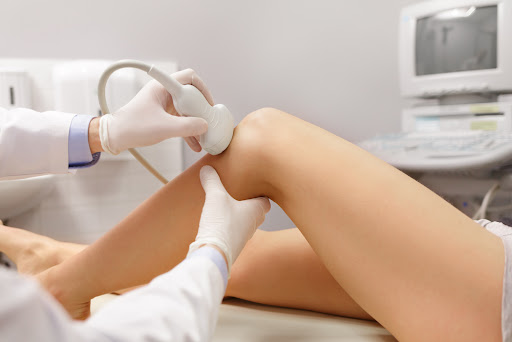Medical ultrasound awareness month only comes about once a year in October. But here at The Vein Centre, we want to ensure the public is aware of the importance of this non-invasive diagnostic tool year-round, especially when it comes to the health of your veins and promoting awareness of often life-threatening vein disorders such as Deep Vein Thrombosis (DVT).
Medical ultrasounds are probably most associated with pregnancy. But ultrasounds are performed for many reasons, many of which are the same reasons why they are performed so frequently on pregnant women; to give an inside look at your health to ensure things like your veins and arteries are healthy.
Even though most people have heard of ultrasound medical imaging, only a few know all its applications, especially concerning vein health. Read on to learn why medical ultrasounds are crucial for many healthcare uses, especially in screening, diagnosing and treating vascular issues such as DVT.
WHAT ARE MEDICAL ULTRASOUNDS?
Ultrasound imaging, also known as sonography, is a type of medical imaging that allows medical professionals to see what’s going on inside your body in a way that is safe, comfortable, and non-invasive.
Unlike x-rays and CT scans, ultrasound imaging does not use radiation. It uses sound waves to generate images inside the body. This process is painless, requires no needles, injections or incisions of any kind, and is generally less expensive than other diagnostic methods.
WHAT ARE MEDICAL ULTRASOUNDS USED FOR?
A medical ultrasound is most commonly known for its usage in pregnancy screening and monitoring. Fetal scans examine the baby in the womb to look for abnormalities like spina bifida, monitor growth and check the position of the fetus. They are also used to determine a baby’s gender.
While fetal imaging is one of the most common uses of ultrasounds, this type of imaging has many other uses that help a physician evaluate, diagnose, and treat various medical conditions.
Patients of any age and for different medical purposes can benefit from an ultrasound.
Here is a breakdown of some things you might not know medical ultrasounds are used for and why they are an important screening tool.
Vascular Health
Vascular scans measure the direction and speed of blood flow, the condition of blood vessels and are an important tool for determining blood vessel issues. Vascular ultrasounds aren’t only great for preventative screenings; they can be lifesaving.
Vascular ultrasounds provide invaluable information about how blood passes through your arteries and veins, potentially detecting a blood clot or other circulatory system blockage. They can also detect any arteries that are blocked or narrowed, which helps in detecting the possibility of a stroke before it occurs.
A little further down, we will discuss why ultrasounds are essential when it comes to screening your vascular health, including more on deep vein thrombosis (DVT) and how ultrasounds are a valuable tool in diagnosing this sometimes serious vein condition.
Heart Health
Another type of ultrasound called an echocardiogram, echo, or cardiac echo is often combined with vascular ultrasounds. This type of ultrasound allows assessment of the heart’s overall function, providing details about the size of the heart, its shape, any possible tissue damage, and more.
Doctors use these ultrasounds to monitor those already suffering from heart disease but can also make it possible to diagnose heart conditions early.
Abdominal Issues
Scans of the abdomen investigate organs like the gallbladder, pancreas, spleen, and kidneys. A wide range of abdominal issues can be diagnosed with the help of ultrasound technology.
Bone Density
Bone sonometry is a type of ultrasound imaging that examines bone density and assesses risk for things such as arthritis and osteoporosis.
Musculoskeletal Conditions
A musculoskeletal ultrasound can help pinpoint the issue if you have problems with your tendons and joints. It can tell doctors if you are experiencing sprains, strains, tears, trapped nerves, arthritis, tendonitis, bursitis, carpal tunnel syndrome, rotator cuff tears, joint problems, masses such as tumors or cysts, and much more. .
Breast Health Screening
Many doctors are ditching x-rays and using ultrasounds to help detect breast cancer, especially in women with dense breasts. Breast ultrasounds provide a better and safer way to check the breasts for unusual masses and are becoming the preferred method for breast health screening.
Respiratory Health
Lung ultrasounds can be a useful tool for doctors to assess the chest wall, to check for things such as pneumonia and other respiratory issues, and for early detection and management of lung disease.
Eye Health
Ophthalmic ultrasounds examine the structure of the eye. They are used to test for retina abnormalities and help diagnose retinal detachment and other eye disorders and lesions.
Cancer
Ultrasounds can help medical professionals detect tumors for all types of cancer that are not visible with other medical imaging technologies.
Urinary Tract Health
Ultrasound exams can be used to examine the urinary tract for a wide variety of potential issues with the kidney and bladder, including infections, blockages, stones, and tumors.
Female Reproductive Health
There are many uses for ultrasonography in examining female organs, such as the ovaries, fallopian tubes, uterus, bladder, and more. Gynecologists use ultrasound to detect things such as endometriosis, ovarian cysts, lesions, and gynecological cancer.
Male Reproductive Health
Ultrasounds are a very useful tool in detecting abnormalities related to impaired male reproductive health and are often used as an initial diagnostic tool to assess infertility. Sonography in males can be used to determine testicular, scrotal, or prostate abnormalities and the condition of the sperm duct.
Medical Procedure Guide
In addition to screening and diagnosing, ultrasounds are a valuable tool to help guide medical professionals during certain medical procedures, such as biopsies.
As you can see, medical ultrasounds go beyond checking on an unborn baby’s health. They give medical professionals an invaluable “third eye” to screen, diagnose, and treat many medical conditions. Your furry family members might even need an ultrasound in their lifetime, as veterinary medicine utilizes ultrasounds similarly to human medicine.
HOW ULTRASOUNDS ARE USED IN VASCULAR HEALTH AND WHY THEY ARE IMPORTANT
When performed by a qualified technologist like the ones we have here at The Vein Centre, vascular ultrasound is a very safe and highly effective tool for identifying the location and severity of vascular problems throughout the body.
Routine vein and artery checks are, in many cases, lifesaving procedures, and vascular ultrasounds are an important tool because they can assess arteries and veins in almost all body parts.
Here are a few reasons why vascular ultrasounds are a valuable diagnostic and treatment tool that we use here at The Vein Centre:
Vascular Ultrasounds Are A Valuable Follow Up Tool
Ultrasound imaging is often used as a non-invasive follow-up for patients who have undergone bypass grafts and stents. Doctors can actively measure the success of these procedures or determine if they are good candidates for these types of vascular procedures.
Vascular Ultrasounds Help Measure Blood Flow
When blood flow is faster than normal limits, it indicates that a vein passage is narrow and is at risk for blockages. By mapping blood vessels this way, your doctor can determine if vessels have blockages and can make sure arteries are open and functioning correctly.
Vascular Ultrasounds Look For Plaque and Blood Clots
Plaque development and blood clots can be spotted with vascular ultrasound. These clots are often found in the legs and arms and are also known as deep vein thrombosis. If left untreated, DVT can cause serious lung, heart, and brain complications.
Vascular Ultrasounds Help Detect Vein Disorders such as DVT
Venous ultrasound is an imaging test that uses sound waves to produce images of veins in the body. It can detect blockages or blood clots in the deep veins and is the standard imaging test to diagnose DVT.
WHAT IS DEEP VEIN THROMBOSIS (DVT), AND WHY VASCULAR ULTRASOUNDS ARE AN IMPORTANT DIAGNOSTIC TOOL FOR DVT
Deep vein thrombosis (DVT) is a blood clot or thrombus in a deep vein. They are most common in the leg but can develop in other parts of the body, such as the arm.
DVT can become life threatening if part of the clot, called an embolus, breaks off and travels to the lungs causing what is called pulmonary embolism (PE). Two other complications of a blood clot are chronic venous insufficiency and post-thrombotic syndrome.
Many people who develop DVT experience leg pain or swelling, but there may be no symptoms in some cases. That is exactly why vascular screenings that include ultrasounds are important.
A vascular ultrasound can assess if there are any clots deep in the veins and where the clot is.
This will enable your doctor to plan your treatment, hopefully before any life-threatening issues arise.
WHAT TO EXPECT DURING A VASCULAR ULTRASOUND
Unlike other procedures that require dyes, radiation, needles, and anesthesia, a vascular ultrasound is non-invasive. A vascular ultrasound is quick (typically takes at most an hour) and easy, has no side effects or dangerous materials, and is completely painless.
Instead of using these invasive techniques, a vascular ultrasound makes use of sound waves that transmit through tissue. These waves create an image as they reflect off blood cells moving through veins. The image created is visible in real-time, which aids doctors in moving about to examine areas of interest.
Here is exactly what to expect when you come in for a vascular ultrasound at The Vein Centre:
- Depending on the area to be tested, you may need to fast beforehand. You might also be asked not to urinate so that you have a full bladder.
- You might want to wear comfortable clothing that’s easy to fully or partially remove. You may be asked to undress and wear a hospital gown.
- You will be asked to lie down and remain still during the exam unless a change of position is needed to capture images.
- A gel is applied to the area to be examined, which allows a transducer to relay images back to a computer and video screen. Ultrasound waves do not work through the air and need fluid to bounce off, which is why the gel is used. These high-frequency waves can’t be heard by the human ear but will be picked up by the transducer.
After a few images are captured, that is it! You can get dressed and go home. While the technologist performing the ultrasound can answer some questions you have about the exam itself, formal results are not provided on the spot. Your images need to be reviewed and interpreted. Our office will call you to discuss your results as soon as your final report is ready.
THE IMPORTANCE OF MEDICAL ULTRASOUND AWARENESS
Because most people only associate ultrasound with pregnancy, it is vital that medical professionals get the word out that ultrasound technology is a valuable and affordable tool that has an essential role in screening for many health issues, such as DVT.
These non-invasive imaging tests can help narrow down a patient’s diagnosis and quickly get them the care they need.
MEDICAL ULTRASOUND AND DVT AWARENESS MONTHS
Medical Ultrasound Awareness Month (MUAM) is recognized every October. It was established to give the public a better understanding of ultrasound and its many uses. Having a month set aside to honor this important medical technology also provides ultrasound professionals a chance to celebrate their profession.
DVT also has its own awareness month every March. This is a time to raise public awareness of this common vein condition and its potentially fatal complications. Up to 2 million Americans are affected annually by DVT, yet most Americans have little or no awareness of DVT. DVT Awareness Month is an excellent time to schedule a vein health screening and encourage your loved ones to do the same!
BOOK YOUR VASCULAR HEALTH SCREENING, INCLUDING A VASCULAR ULTRASOUND IN MIDDLE TENNESSEE
We believe routine vascular screenings that include vascular ultrasounds and a better understanding of the options available to our patients will ensure vascular health and help prevent many life-threatening vein issues.
Our doctors are compassionate, board-certified vascular surgeons in the Nashville area with the experience needed to correctly read medical ultrasound images.
If you are looking to schedule a vascular ultrasound for routine screening, are experiencing pain, would like to further assess varicose veins, or are concerned about vein disease such as DVT, contact our office to book your appointment.
VASCULAR SCREENING

Are you at risk?
Find out if you are at risk for common vascular diseases with a vascular screening. Vascular screenings can help catch any irregularities in your veins like buildup or plaque and potentially prevent issues before they get worse.
→ Stroke
→ Abdominal Aortic Aneurysm (AAA)
→ Peripheral Arterial Disease (PAD)



